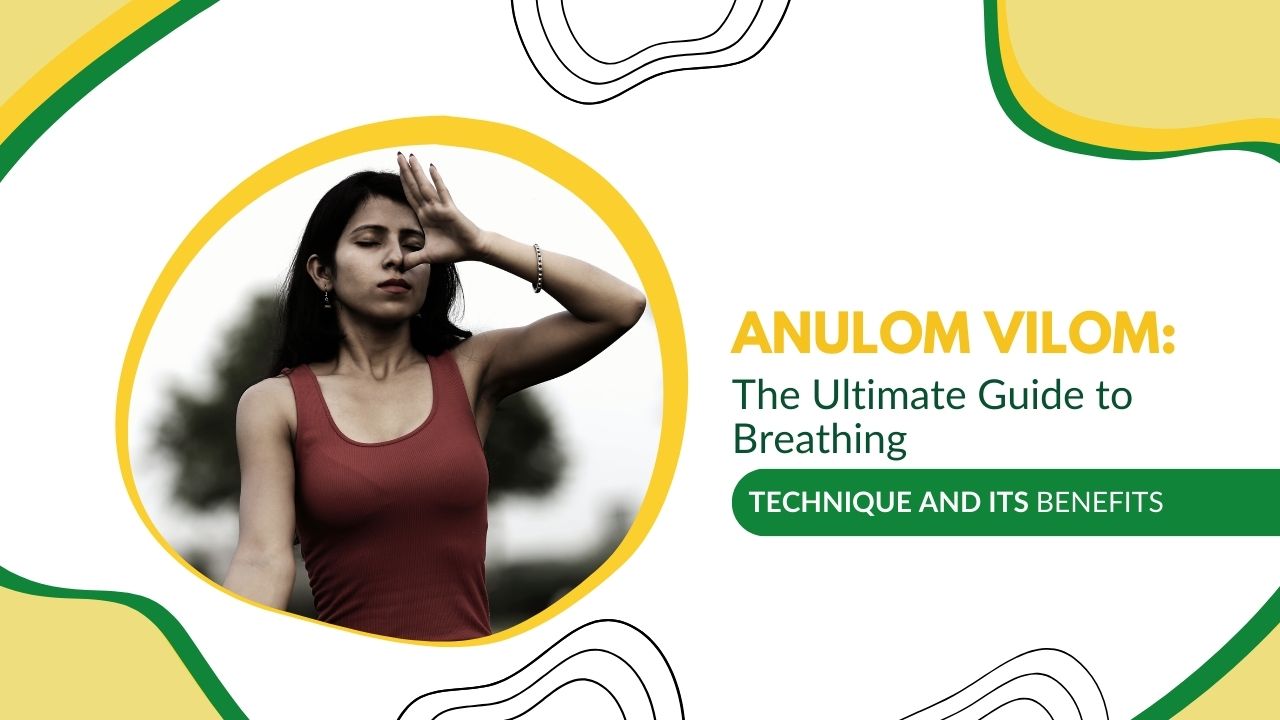Table of Contents
ToggleWhat Is Ujjayi Pranayama?
Pranayama, or the control of the breath, is a crucial aspect of yoga practice. It helps to regulate the flow of prana, or life force energy, throughout the body and can have a profound impact on the physical, mental, and emotional well-being.
One such pranayama is Ujjayi pranayama. It is a specific technique that involves constricting the back of the throat to create a soothing, ocean-like sound during inhalation and exhalation. Thus, it is also called “Ocean Breath.” It is said to help calm the mind and promote feelings of relaxation and inner peace.
These benefits are just the tip of the iceberg; let’s take a closer look at an array of Ujjayi pranayama benefits.
Ujjayi Pranayama Benefits (उज्जायी प्राणायाम के लाभ)
1. Calming Effect on the Mind
The soothing sound of the breath during Ujjayi pranayama helps to focus the mind and reduce stress and anxiety. The sound of the breath can act as a form of meditation, helping to clear the mind of distracting thoughts and promoting a sense of inner peace and relaxation.
2. Improved Lung Capacity
The technique of slightly constricting the back of the throat during breathing increases the resistance to the airflow, which helps to increase the strength and capacity of the lungs. This can help to improve the efficiency of the lungs and reduce shortness of breath.
3. Increased Oxygenation
The deep and slow breathing of Ujjayi pranayama helps to increase the oxygenation of the blood, which in turn can help to improve overall health and vitality. The increased oxygenation can help to boost the immune system, improve energy levels, and reduce fatigue.
4. Improved Circulation
The deep and slow breathing of Ujjayi pranayama helps to increase the blood flow throughout the body, which can help to improve circulation and reduce fatigue. Improved circulation can bring more oxygen to the cells, organs, and muscles which can help to remove toxins and improve overall function.
5. Improved Digestion
Ujjayi pranayama can help to stimulate the digestive system, which can help to improve digestion and reduce bloating and constipation. It helps to stimulate the movement of the diaphragm which can help to massage the internal organs and improve their function.
6. Improved Sleep
Ujjayi Pranayam can help to calm the mind and promote feelings of relaxation, which can help to improve sleep and reduce insomnia. The practice of Ujjayi pranayama can help to reduce stress and anxiety, which can make it easier to fall asleep and stay asleep.
Read More – Five Pranayamas To Include In Your Everyday Exercise Routine
Increased Focus and Concentration
Ujjayi pranayama can help to focus the mind and increase concentration and mental clarity. The sound of the breath can act as a focal point, helping to keep the mind grounded in the present moment and reduce distractions. Additionally, deep and slow breathing can help to improve oxygenation to the brain, which can help to improve cognitive function and mental clarity.
Fun Fact: The practice of Ujjayi pranayama is said to have been used by ancient yogis to help them maintain focus during long periods of meditation.
If you want to deepen your yogic knowledge, you can join our 200-hour Teacher Training Course at Rishikul Yogshala in Hrishikesh. Our top-rated 200-hour Yoga Teacher Training in Rishikesh, India is tailored to provide students with a comprehensive understanding of classical yogic principles to enhance their yogic journey
How to Perform Ujjayi Pranayama (उज्जायी प्राणायाम)
Ujjayi pranayama is a relatively simple technique that can be practiced by most people with proper guidance. Here are the basic steps for practicing Ujjayi pranayama:
- Sit in a comfortable position, with your back straight and your shoulders relaxed. You can sit on a cushion or a chair, as long as your spine is upright.
- Close your eyes and bring your attention to your breath.
- Take a deep breath in through your nose, and exhale through your nose.
- As you inhale, gently constrict the back of your throat to create a soft “hissing” sound. The sound should be audible but not too loud.
- As you exhale, again constrict the back of your throat to create the same “hissing” sound.
- Continue to inhale and exhale deeply and smoothly, making the “hissing” sound with each breath.
- Try to keep your breath steady and even, and maintain a consistent pace.
- Practice for 5 to 10 minutes, or as long as you feel comfortable.
- End your practice with a deep inhale and exhale, and then open your eyes.
Variations of Ujjayi Pranayama
There isn’t just one way of doing this magical breathing practice. Here are a few variations:
1. Nadi Shodhana Ujjayi
This variation combines Ujjayi pranayama with the alternate nostril breathing technique (Nadi Shodhana). Nadi Shodhana is a form of pranayama that involves breathing in through one nostril, then out through the other, and then switching. This variation can help to balance the energy channels in the body and promote a sense of mental and emotional balance. It’s said that it can help to reduce anxiety and depression and improve overall well-being.
2. Ujjayi With Kumbhaka
This variation involves holding the breath after inhaling and before exhaling. This is called Kumbhaka. This can help to increase the amount of oxygen in the body and promote feelings of calm and inner stillness. It’s also said that it can help to increase the internal heat and energy flow in the body and promote detoxification.
Did you know: Some yogis also believe that Ujjayi pranayama can help to stimulate the thyroid gland, which is responsible for regulating metabolism
Common Mistakes While Doing Ujjayi Pranayama
There are a few common mistakes that people may make when practicing Ujjayi pranayama:
- Over-constricting the throat: One of the most common mistakes is to over-constrict the back of the throat, which can lead to strain or discomfort. It’s important to find a balance and keep the sound of the breath smooth and even.
- Holding the breath: Holding the breath during Ujjayi pranayama can be dangerous and should be avoided. It’s important to keep the breath smooth and even and to exhale fully before inhaling again.
- Practicing when ill: It’s important to avoid practicing Ujjayi pranayama when you have a cold or other respiratory infection. Doing so can make the symptoms worse and delay recovery.
- Not warming up properly: Before starting any pranayama practice, it’s important to warm up the body with some gentle stretches and movements.
Also Read – Bhramari Pranayama: Steps, Benefits, Precautions, and More!
Conclusion
Ujjayi Pranayama or ocean breath, is a powerful and versatile yoga breathing technique that can have a positive impact on the mind and body. It’s a technique that can be practiced by most people and can be adapted to suit different levels of experience and specific needs. From its calming effect on the mind to improved lung capacity, circulation, and digestion, Ujjayi pranayama offers a wide range of benefits. It’s important to approach this practice with care and under the guidance of a trained yoga teacher and to consult a doctor before starting any new exercise practice, particularly if you have any health concerns.
Incorporating this pose into your practice can lead to significant improvements in overall well-being. For those interested in deepening their yoga journey, consider enrolling in a yoga teacher training program. Rishikul Yogshala, a leading Yoga school in Rishikesh, offers comprehensive courses like the 100 Hour Yoga Teacher Training In Rishikesh, 200 Hour Yoga TTC In Rishikesh, 300 Hour Yoga Teacher Training In Rishikesh, and 500 Hour Yoga Teacher Training Rishikesh. These programs are designed to help you master your practice and share the transformative power of yoga with others.








